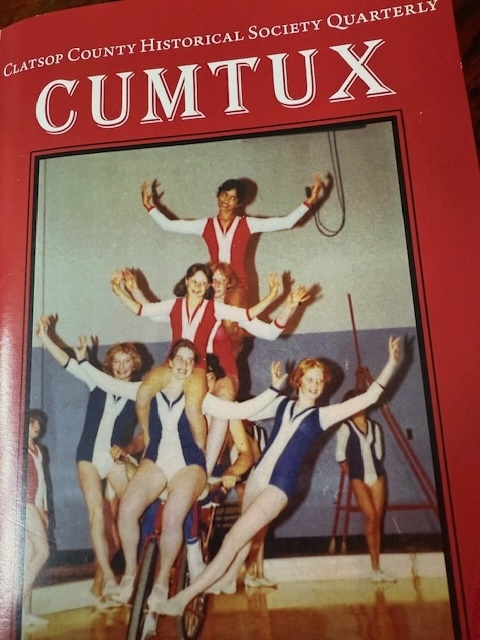The enduring Grange
Published 3:40 am Thursday, March 26, 2009

- Ray Raihala is the Grange Master of the Wickiup Grange in Svensen. He grew up nearby in Brownsmead and has watched membership and interest in the Grange recede beneath a wave of modern life.
Wickiup Grange
Trending
A Grange hall reinvents itself
Ray Raihala admits his membership with the Grange began with economic self-interest in mind. Grange insurers simply had the lowest rates around, and Raihala wanted in.
But his memories of the Grange go back even further. Raihala recalls being small enough to fall asleep under a coat during a dance at the Wickiup Grange. When he woke up, he remembers taking account of his surroundings.
Trending
“There were so many people in there,” says Raihala. “Those wooden floorboards were just bouncing.”
Although the floorboards still bounce when a good dance gets going, membership numbers have indisputably dwindled.
These days, the Wickiup and the Brownsmead granges hold their monthly meetings together for the sake of convenience.
“Realistically, we don’t have enough members to hold individual meetings,” Raihala says.
Somewhere along the way, Raihala went from being a car insurance customer to a car insurance salesman. He still keeps a small office on Duane Street in downtown Astoria.
But those early days are still alive in him.
Raihala grew up a little down the way in Brownsmead, and still lives in the house his granddad put up in 1910.
He has come to respect the Grange as a “grass-roots political organization.” He says what’s done locally can influence state grange policy.
“There’s a community service purpose to the Grange,” he says.
Raihala is also a realist and he knows the once-mighty Grange has suffered as rural populations flocked to the cities.
Yet when he speaks of the Grange, there is no sense of remorse or sadness in his voice. The Grange is something that is still very much alive to him.
He says efforts to make the Grange more approachable are being made. Modernization has made inroads.
For instance, some of what Raihala calls the “archaic language” of the Grange has been set aside – like the secret signs and passwords that separated the “first-degree Granger” from the “second-degree Granger.” In the old days, it took four months to fully become a member. Now it only takes a night.
Nearly 100 years old, the Netel Grange has weathered the elements only with the ongoing support of human intervention. Monthly dances, infused with the energy of live old-time country music, breathe fresh life into the structure.When Raihala became the Wickiup Grange Master, or president, he realized his biggest challenge would be maintaining the condition of his castle. Rotting timbers, peeling paint and other ongoing projects continue to keep him busy.
Yet he and other community partners are working hard to make the hall available as a temporary shelter in the wake of a natural disaster or emergency.
Bathrooms have been remodeled, making them accessible to the handicapped and elderly. Shower space has been added, and generators will also be installed.
Teamwork and dedicated players are more esential than ever if the Grange is to survive as an organization. Donna Karns, left, Charlotte Langsev, center, and Lorelie Beckwith do the behind-the-scenes work cleaning up after the Valentine’s Day Spaghetti Feed at the Brownsmead Grange.”My personal feeling is that the largest good the Grange can do is to maintain these buildings for the local communities,” says Raihala.
Brownsmead Grange
More than spaghetti and corn
The Brownsmead Grange is close to 100 years old and plenty of money goes into maintaining it.
This year’s Valentine’s Day Spaghetti Feed aimed to raise some funds toward that effort. Sure enough, by night’s end, several dozen couples and singles had been fed a good meal and the thin Grange coffer got just a little bit thicker.
Much of John Westerholm’s life has woven through the Brownsmead Grange. A former farmer, school teacher and fisherman, Westerholm now finds himself in the role of Grange Master.Jon Westerholm is the Grange Master of the Brownsmead chapter. He presides over the meetings and works with volunteers and members to make sure events like the spaghetti feed go off without a hitch.
Other than that, he’s just like any other member of the Grange – dedicated, hardworking and extremely dedicated to the people in his community, and on this night, he and his ilk are most likely to be found in the kitchen.
That’s where Grange members Charlotte Langsev and Lorelie Beckwith are dishing up noodles and sauce and keeping an eye out to see diners are comfy and well-fed.
Gina Kytr swings with Craig Holt during a monthly dance at the Netel Grange.Beckwith says reaching out to the community at large is more important than ever to the health of the Grange. Renting the hall is one of the Brownsmead Grange’s primary sources of income.
“We want things to come in that will bring income to the Grange,” says Beckwith.
Funds not eaten up by leaking roofs, heating bills or plumbing problems get stored away into a general fund. The money has supported logging classes and scholarships for local students.
The Grange still lobbies in support of farming communities, but membership has shrunk and many of the old buildings have fallen into disrepair. The Brownsmead Grange has fought the odds and still fills an important role to its local residents.There was a time when the rural Grange Hall was a thing of necessity, and these days, in Brownsmead at least, the hall functions very similarly.
With its vast wooden arched ceilings, the hall is the only building of its kind in Brownsmead that can accommodate a large group of people for indoor events.
Multi-family Thanksgiving dinners have staked out in the Grange … weddings, receptions, meetings, and of course, the famous Brownsmead Corn Feed.
Westerholm has called Brownsmead home most of his life, and his history with the Grange goes back just as far.
“I learned how to play basketball in this place as a kid,” he says.
The Brownsmead Farmers, they were called.
Westerholm is also a farmer of the real dirt and potatoes variety. He has also lived life as a commercial fisherman and school teacher.
He has watched the land go from crops to cattle.
Through it all, the farmers, the land and the Grange have been there.
“Different generations have come along,” says Westerholm. “Now it’s my turn, and Charlotte’s, and others, to maintain what our forefathers have started, and to keep it going.”
Netel Grange
Dance threads past to present
A cold rain falls hard, and slush has covered the road leading out to Netel Grange. But inside, the hall is light, and a constant flow of hot air filters through iron vents in the wooden floors.
A handful of dancers quickly becomes a dozen. A few more filter in and the hall has reached a cozy capacity.
The Netel Grange was put up in 1910, and the floor of the old building has bounced with dancers since at least 1918. This chilly March evening is no different, and when the band starts playing, the feet hit the floor.
The little wooden building has been and is host to many charms, and many ghosts, mostly the friendly variety.
None shine brighter than the enigma of Deacon Lawton. Actor, circus performer and painter, it was his hand that painted the ornate proscenium that decorates the stage to this day.
Lawton produced many plays and shows in the 1920s within the little Netel Grange. In the ’30s, his “Laffalot Circus” became the talk of the town.
Joseph Stevenson, Netel’s current Grange Master, discovered Lawton’s charms bit by bit. First, he found an old photo of the Deacon.
“You can see he’s an old codger with a twinkle in his eye, and not a pillar of the church,” says Stevenson. “I got very fascinated with him. I always kind of feel like he’s around.”
Stevenson also pulled from an old storage closet three mysterious portraits made by Lawton. He soon realized they were icons of the Grange theology: Pomona, Flora, Ceres. Or, Fruit, Flowers and Grains.
“Even the old-timers had never seen them before,” Stevenson says of the portraits of the goddesses, which now hang in the Grange Hall.
Stories of Lawton’s exploits have served as inspiration for Stevenson’s own musical and theatrical productions within the Netel hall.
One of Stevenson’s first was “A Tribute to Woody Guthrie,” and it became an instant hit.
The history of these productions is well-documented in photographs that line the walls of the Grange.
One glance at these photos of young people buzzing about over sunlit floors, trading costumes, building sets and playing instruments, reveals the hall has been a place of creativity, mentorship and growth.
Perhaps none of Stevenson’s endeavors have been more successful than his monthly dances. He first came up with the idea in 1979.
Through them, he is happy the Netel Grange has provided a place “people of all ages can come and enjoy.”
The building will turn 100 next year and Stevenson has invested his heart and soul for at least 40 of those years. He’d like to see the Grange live on at least another 40.
“I’ve had a long love affair with this building,” explains Stevenson. “and it seems like when one person gets tired, another steps up to the plate, and that person right now is Craig Holt.”
Holt is more than the Netel Grange treasurer. He has appointed himself the first line of defense in this old building’s ongoing battle with the elements. He is also the No. 1 promoter of the monthly dances.
Sometimes those two jobs combine, like when the 2007 storm blew a hole in the roof, threatening to cancel the January dance.
Holt waited for a clearing in the deluge, then mopped up the mess so the dance could go on. When rain waters later threatened the integrity of the structure, Holt paid out-of-pocket to have the roof repaired.
“You can’t have dances without the Grange, and there’s no sense in having a Grange if you don’t have dances,” says Holt.
The National Grange is the nation’s oldest national agricultural organization, with grassroots units established in 3,600 local communities in 37 states. Its 300,000 members provide service to agriculture and rural areas on a wide variety of issues, including economic development, education, family endeavors, and legislation designed to assure a strong and viable rural America. It was formed in the years following the Civil War to unite private citizens in improving the economic and social position of the nation’s farming population. Over the past 137 years, it has evolved to include nonfarm rural families and communities.
The Grange is also a fraternal order known as the Order of Patrons of Husbandry, hence the “P of H” on the organization’s logo. Founding members determined that a fraternal organization would be best able to combine loyalty and democratic ideals to provide service to others. The National Grange was one of the first formal groups to admit women to membership on the basis of equality with men. It remains so today.
– from www.NationalGrange.org









